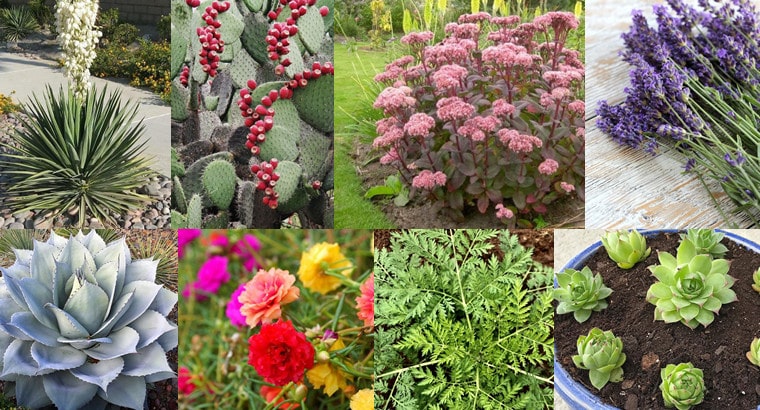Most people believe that, in order to have a beautiful and blooming garden, they have to put all their spare time and money into it. However, that is usually not the case. All that’s really necessary is to load your garden up with drought-tolerant plants.
The sections that follow will introduce you to the best drought-tolerant plants and teach you how to care for them. Get ready for the garden of your dreams!
An Introduction to Drought-Tolerant Plants

As their name suggests, drought-tolerant plants are those that do not require too much water or moisture to develop fully and thrive in a certain environment. Different plants in this group have this characteristic for various reasons.
For example, cactuses and succulents have built-in systems that allow them to keep moisture inside their bodies. In the case of these plants, the excess moisture is kept inside of the leaves, which is what gives them their fleshy and thick appearance. Other plants in this group have different systems that help them regulate moisture levels.
On the other hand, there are plants that have tap roots that can reach deep into the earth. There, they can find water and a lot of minerals that help them grow healthy even if they do not get watered often.
Certain plants can also hold moisture in structures such as rhizomes, corms, and bulbs. These structures are connected to the root but are not a part of it. Whenever a plant is not getting enough water, it can slowly drain these reservoirs and stay just as rich and grandiose like at its peak.
You Need to Be Careful
Most people believe that drought-tolerant plants will start thriving immediately after they plant them, no matter the conditions. However, that is not the case. Even the toughest and most resilient varieties will struggle if you take them from a greenhouse and plant them in the driest possible conditions.
Thus, you need to be smart about when you plant these flowers. It is best to plant them either in spring or in the fall, when there is at least some water. So, when the drought period comes, they will have adjusted well to receiving less moisture. Then, they will be able to do their magic and look amazing even without any rain.
If you absolutely have to plant them in the summer, you should still water them periodically. That is necessary in order for them to get used to holding water in such conditions.
If your area is experiencing its driest and hottest season yet, checking up on your plants is a must. Even if they are drought-tolerant, they will still need some help getting by in extreme heat. Making sure they have enough moisture is the key to getting them through a tough period.
The Best Drought-Tolerant Plants for Your Garden
Without much further ado, here are the best drought-tolerant plants that will make your garden look more beautiful and dreamier than ever.
1. Adam’s Needle (Yucca)
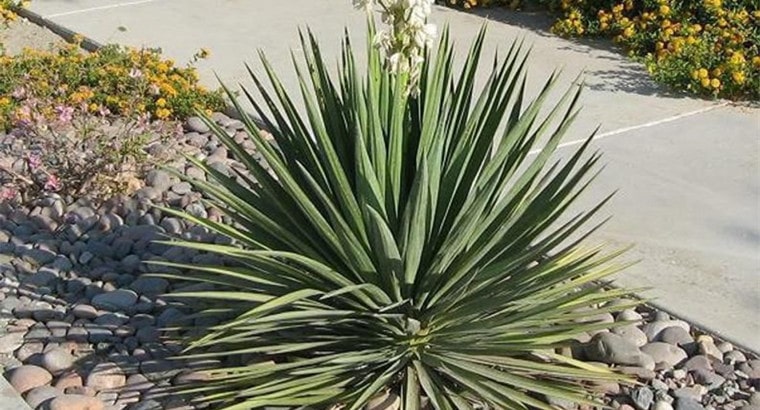
Image source: Pinterest
Adam’s Needle is a type of cactus that thrives in extreme heat. This plant keeps excess water in its tap roots that can reach several meters underground and find everything they need there.
What draws most people to this plant is the extravagant flower stalk that is at its center. It is covered with white, violet, and yellowish flowers and it makes the whole plant appear quite grandiose. Rich green leaves are scattered all around this stalk, contrasting with the flowers.
If you need a centerpiece for your garden that will make it look sophisticated and rich even during a drought, this plant is the way to go.
The only thing you should remember is never plant Adam’s Needle in areas that are both wet and cold. As mentioned above, it needs the sun and hot temperatures to get by, and the opposite could make it lose its luster.
2. Agave (Agave)
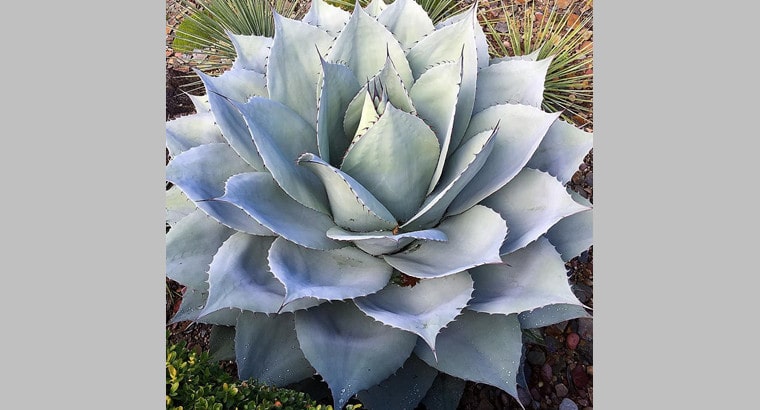
Image source: Pinterest
Most people know Agave as the plants that are used to make tequila. However, in gardening circles, they are known as aesthetically pleasing powerhouses that can make any garden look elegant.
Agaves have roots and root structures that can hold onto water and store it for when it is needed. They can do so with rain, dew, and the water you spray on the ground. Thus, the plant will remain healthy even if it doesn’t get fresh water for a while.
Blue agaves, the variety that most people go for, do not grow to be as tall as the first pick on this list. However, they are a great choice for pathways and other garden borders. Their leaves are arranged so that they resemble a flower, almost like a giant green rose.
Once every few years, blue agaves can actually bloom. The flowers are small and spikey, but they are extremely aesthetically pleasing.
However, blue agave is not the only variety out there. In fact, there are at least 300 more varieties you can pick for your garden. Some flower only once and die, while others can grow and develop for years. It is up to you to see which type fits into your garden best.
3. Prickly Pear (Opuntia)
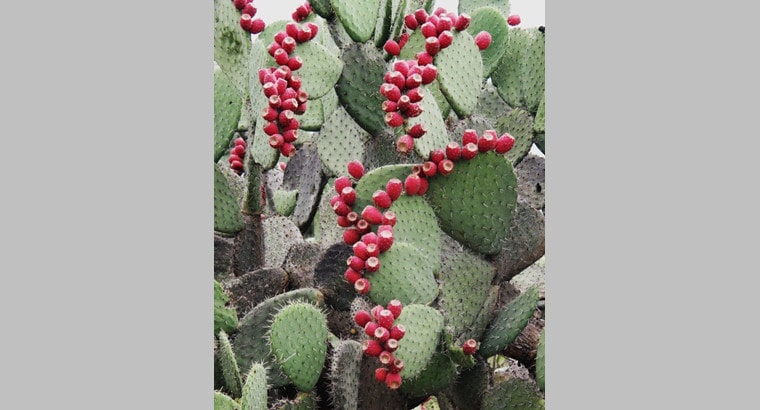
Image source: Pinterest
This cactus is for all of you who want their garden to look as funky and unconventional as possible. It has a typical cactus body covered with yellow, red, or white flowers during spring and the beginning of summer.
As soon as temperatures spike, the flowers start morphing into rather funny-looking fruits. They are orange in color, and they have tiny nubs all over them. That is how they got their name. Just by looking at them, you’d think that you were seeing some strange, prickly pears.
The best thing about these fruits is the fact that they are edible. People describe the taste as a perfect mix of sweet and sour that can make any hot summer day miles better. Apart from the fruits, opuntia leaves are edible as well.
This plant can survive extreme heat well, thanks to its succulent nature. Instead of keeping water in the leaves or root, the plant has adapted to keep it all over its skin, meaning that each part of it always has enough water for the plant to thrive.
4. Moss Rose (Portulaca Grandiflora)
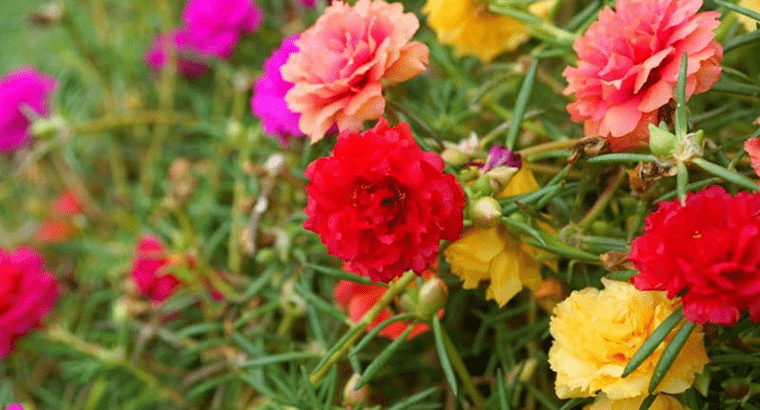
Image source: Pinterest
If you want a drought-tolerant plant that is not a cactus and has actual flowers, you should go with moss rose. This stunning plant has orange, purple, red, yellow, and white flowers that are nearly fluorescent. The leaves are bushy and light green, offsetting the petal colors beautifully.
The leaves are the reason behind this plant’s ability to thrive in dry places. They are succulent, meaning that they can keep excess water inside of them. That way, the plant can stay lush even if it doesn’t rain for weeks.
These flowers are so varied and beautiful that they can fill out a whole garden or hanging basket all by themselves. If you want some variety, you can pair these flowers up with cactuses and succulents.
5. Living Stones (Lithops)
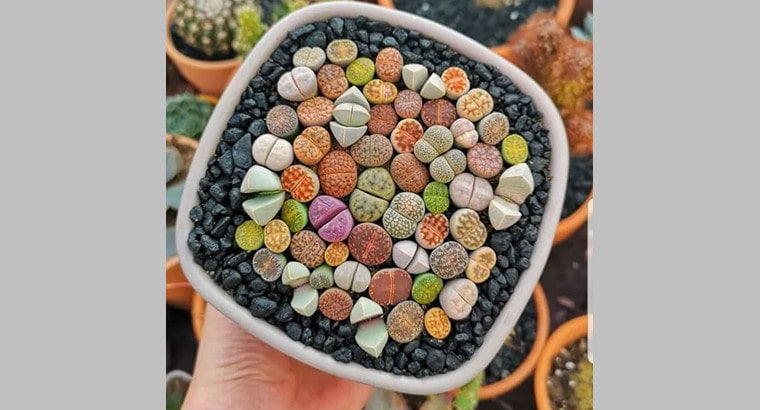
Image source: Pinterest
This plant’s name will make sense to you as soon as you lay eyes on it. It looks so much like a stone that not many people would actually notice that it is indeed a living plant.
Lithops have a completely different way of surviving droughts than any of the plants mentioned so far. They do not retain excess fluids inside their roots, skin, or leaves. Instead, they simply retreat back into the ground when water is really low.
This plant’s appearance is a story of adaptability and survival. The main habitat for lithops is rocky areas. To protect themselves from any lurking herbivores, the plants learned how to camouflage themselves to look like the rocks they were growing around. They succeeded, and not many predators can actually tell them apart from rocks.
The only time you’ll notice these plants looking like anything other than rocks is at the beginning of autumn. That is when a single flower emerges from the middle of the plant, making it look rich and colorful.
Lithops can be a great addition to your garden if you place them near pathways, as they are some of the best border plants out there. They are also great for hanging baskets.
6. Hen and Chicks (Sempervivum)
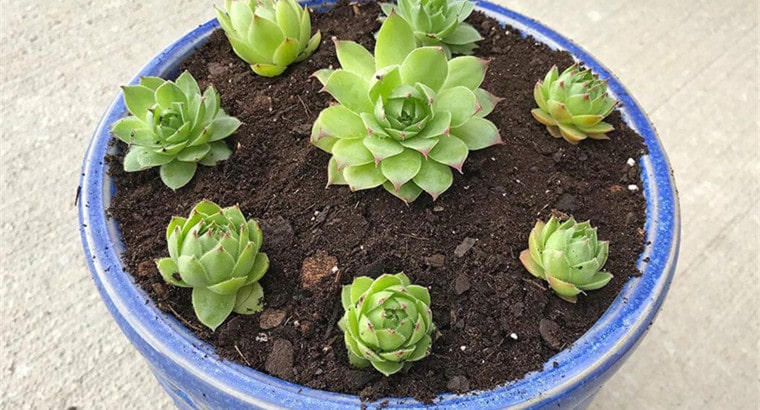
Image source: Pinterest
These flowers are ground-hugging, which makes them perfect for gardens. The rosettes grow slowly and spread over the ground, covering everything in their wake. Once they bloom, your garden will be filled with small purple flowers with twelve petals that smell amazing.
However, these succulents are just as pretty when they are not in bloom. The leaves are thick and layered, which makes the plant look like a green and white rose. Certain varieties have glossy leaves, while others have those with downy white hairs that can give the plant an eerie look in the early mornings and nights.
Apart from not needing too much water, these plants also thrive in poor soils. Thus, they will not need any additional minerals, supplements, or special care. Plant them and leave them be, and your garden will begin looking like a dreamy fairy tale in no time.
7. Stonecrop (Sedum)
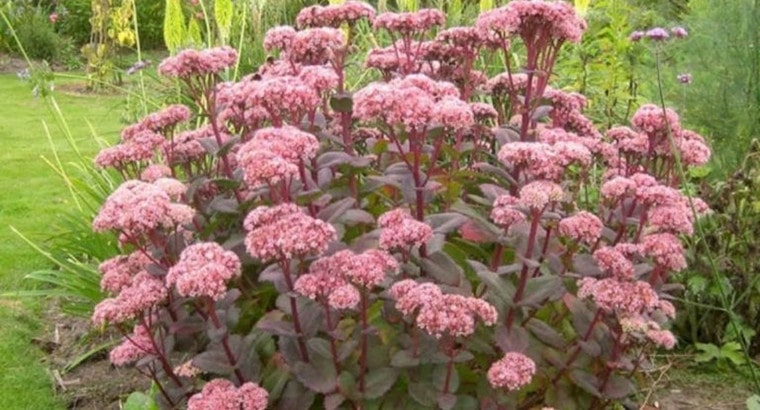
Image source: Pinterest
This genus of plants has something for everyone. If you want late bloomers that will reach a few feet high and attract bees and all kinds of butterflies, you can go for Thunderhead varieties.
Alternatively, you can pick ground-hugging types that will be perfect for pathways and borders as well. You can even find certain varieties that drape over walls and fences.
Regardless of which type you go for, the plants will be as low-maintenance as they can get. You won’t need to water them a lot, and you can plant them in poor soil as well. All they will need is sunlight, which shouldn’t be a problem in dry areas.
The greatest thing about these plants is their aesthetic versatility. You can find those with flowers in just about any color, from yellow and orange to purple and red. There are also those whose leaves are much more dominant, so they are mostly green with white specks.
Thus, no matter what type or color of flower you need for your garden, you will be able to find it within this genus. That is what makes it one of the best drought-tolerant plants out there.
8. Lavender (Lavandula)

Image source: Pinterest
Not many people know that many herbs are extremely drought-tolerant. Out of all of them, lavender is, perhaps, the most popular one to plant in a garden. When you think about it, that makes a lot of sense.
Lavender is one of the most fragrant herbs out there. It is said to promote relaxation, which is why it is used in aromatherapy so much. Aside from that, it also has a lovely violet color that can be a great addition to any garden.
Lavender is native to the extremely dry and sandy Mediterranean landscape, which is why it is tolerant of drought. Once you establish it in your garden, it can go quite a while without getting water and under a lot of sunlight.
However, the fact that you need to give plants some time to adjust to dry conditions is the truest for lavender. You cannot plant it and expect it to thrive without water immediately.
In most cases, it will take between six months and a year for the plant to adjust and learn how to retain water on its own. Until then, you will have to provide some water if the drought is extreme.
Apart from the violet buds you know and love, lavender also comes with silvery-green foliage. It will spread quickly and contrast with the purple color nicely. If you also plant some crawling plants around the lavender, you’ll get a garden that will look, feel, and smell complete.
9. Artemisia (Artemisia)
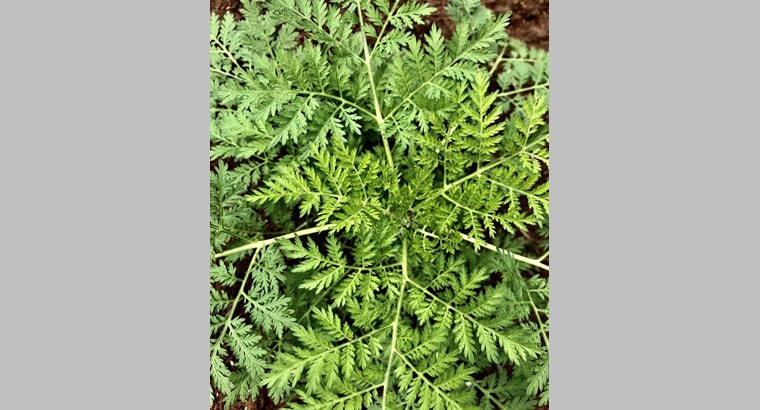
Image source: Pinterest
Artemisias are a large genus of plants that are all drought-tolerant and can thrive in poor soils. In this genus, you can find different hardy shrubs and some herbs, including sagebrush and tarragon.
Most gardeners prefer species such as wormwood and silver mound. They both have a rather intricate leaf structure and green foliage that appears silvery under the light. That makes them great choices for pathways and borders.
As tough as they are, these plants combine perfectly with other drought-tolerant varieties, namely succulents and some ornamental grasses. You won’t have to water them at all, and you’ll always be able to enjoy their aromatic and unique scent.
10. Rosemary (Rosmarinus Officinalis)

Image source: Pinterest
Rosemary is yet another herb that can make a surprisingly great addition to your garden. Aside from smelling great and looking pretty, it also requires little care and watering, making it a perfect choice for dryer areas.
What many don’t know is that this plant can actually grow to be over five feet tall. However, it will take a lot of time to do so, and you can always cut it if it starts getting out of hand.
A fantastic thing about planting rosemary is that you will always have a fresh supply of the herb for teas and cooking in general. This plant grows all year, so it might need some protection during winter. That is especially the case if your area has harsher winters.
11. Yarrow (Achillea Millefolium)
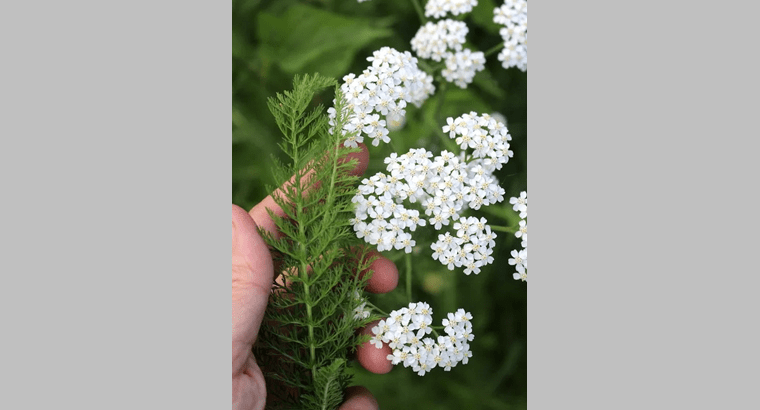
Image source: Pinterest
This perennial has some of the longest blooming periods out of all the options on this list. It looks extremely visually appealing with its deep purple, red, and orange flowers and rich green leaves. However, its health benefits rival its beauty. The aromatic properties of yarrow promote relaxation.
What most people adore about yarrow is its versatility. You can plant it just about anywhere in a garden and have it thrive. It serves well as a border plant, and it can drape and crawl over fences and walls. What’s more, it can serve as a great ground cover in rocky gardens or an edging plant in vegetable gardens.
Another interesting use for yarrow is that of a lawn covering plant. Some people like to forgo grass and plant yarrows across their lawns, and it is easy to see the appeal. This plant spreads and covers the ground quickly, and when it blooms, the lawn looks truly magical. Unlike most grasses, it needs little moisture to look good and healthy.
12. Sage (Salvia)

Image source: Pinterest
This genus includes more than 1,000 plants. Though they are vastly different from one another, two things bring them all together. First off, they are all drought-tolerant. Second, they are late bloomers that are at their most beautiful in the fall.
As long as you plant salvias in a dry area and never overwater them, they will surprise you with their aromatic fragrance and beautiful flowers. If you need something to spruce things up in your garden, no plant will be as fitting as sage.
13. Creeping Thyme (Thymus Serpyllum)

Image source: Pinterest
Many varieties of thyme will survive in dry conditions. However, none are as drought-tolerant as creeping thyme. No matter how dry the area and how poor the soil is, this plant will find a way to thrive and look good while doing it.
Just like lavender, creeping thyme is native to the hot and dry Mediterranean. That makes it a perfect choice for gardens in any hot and rocky area, especially those in the driest parts of the US.
As its name suggests, this plant creeps across surfaces and hugs them closely. It can attach to anything, but it is best used as a bordering or edging plant in ornamental or vegetable gardens.
Once you plant it, creeping thyme will slowly spread over the ground and cover it like a soft carpet. When it blooms, the lush green carpet will be covered in tiny rosy buds that will make the entire image appear magical.
If you’re ever able to and you don’t mind getting a little dirty, you should try walking over thyme-covered ground barefoot. The feeling is truly indescribable.
Of course, you can also use thyme as an aromatic herb that goes into many meals. Considering its famous health effects, you can only benefit from growing it in your garden.
14. Feather Reed Grass (Calamagrostis Acutiflora)
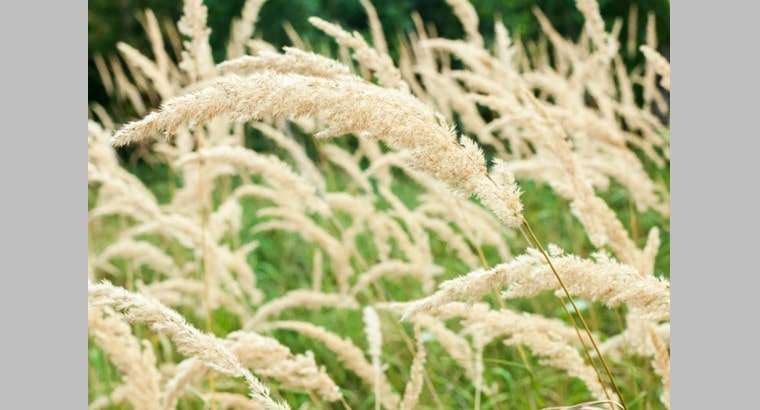
Image source: Pinterest
This ornamental grass can survive the driest conditions that you can imagine. It is sturdy and beautiful, and it can make a visually appealing addition to any garden out there.
Feather reed grass has long, erect flower plumes that move gracefully with even the smallest of winds. When they move, they resemble spider legs and look rather magical.
If you need a plant that will help you edge your garden into vertical lines, this one will make a perfect choice. And the best thing is, you won’t have to do anything to care for it. All you have to do is plant it, and it will take care of the rest by itself.
15. Fountain Grass (Pennisetum Setaceum)
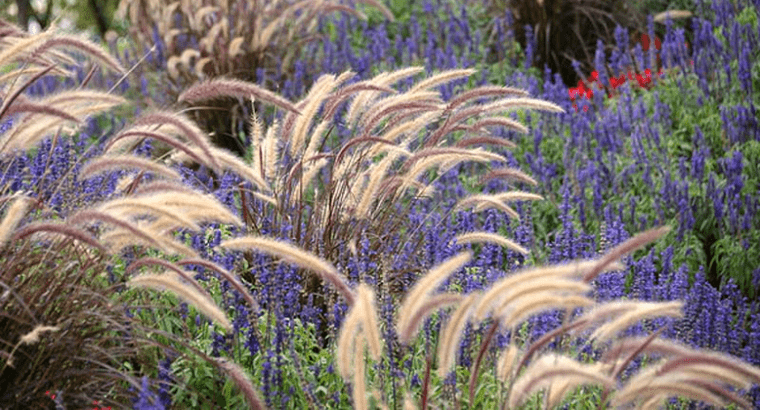
Image source: Pinterest
Just like the grass type above, the main appeal of this variety is how good it looks when a wind blows across a garden. Fountain grass comes in a lovely purple color that can add depth to any garden, especially one that needs a bit of color.
This grass is as low-maintenance as they come, requiring no care and little water. It will make your garden look rather whimsical and dreamy, like one straight out of a story about fairies.
Fountain grass can grow to be over three feet tall. Thus, you shouldn’t plant it near pathways or garden borders. Rather, plant it right in the middle or in any corner where it will have space to grow without obscuring any other plants.
Another excellent fact about this grass is that it blooms for a long time. You can expect the rosy buds to stick around for months, from the middle of summer up until the first frosts.
16. Sweet Potato Vine (Ipomea Batatas)

Image source: Pinterest
If you want to add a lush and tropical touch to your garden, going for sweet potato vines is a great idea. These vines look so rich and grandiose that it is impossible to tell they do not require any water and can thrive in poor soil.
Sweet potato vine foliage can be trailing, climbing, or a combination of both. As far as colors go, you can find varieties in bronze, green, and purple, and choose one based on what your garden needs.
Apart from outside, you can also grow these vines in pots or use them as bedding plants. Either way, they will look amazing and add some sophistication to any place you put them in.
17. Trumpet Vine (Campsis Radicans)
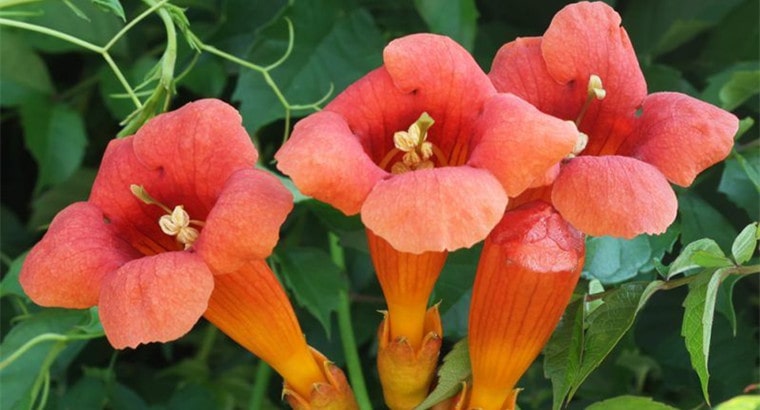
Image source: Pinterest
This vine is adorned with an astounding amount of tubular flowers in deep red. As such, it looks quite exotic and rich. Despite its appearance, it needs little care and can survive in extreme heat quite well.
The only thing you’ll have to do when it comes to this vine is to prune it back from time to time. It is a rather vigorous grower, so it can get out of hand pretty fast. Still, you can just leave it be if it is not overcrowding your garden and you like the way it looks.
These vines can thrive both in the sun and in partial shade, so you can pick pretty much any spot to plant them in.
18. Bougainvillea (Bougainvillea)

Image source: Pinterest
If your main concern is finding a drought-tolerant plant that is colorful and looks extravagant, you will love bougainvilleas. These viney flowers come in a dizzying amount of colors, ranging from white and yellow to deep red and purple.
These flowers will make great border plants that need little water and thrive in direct sunlight. Just like many others on this list, this flower requires no care at all, so you can just plant it and leave it be.


